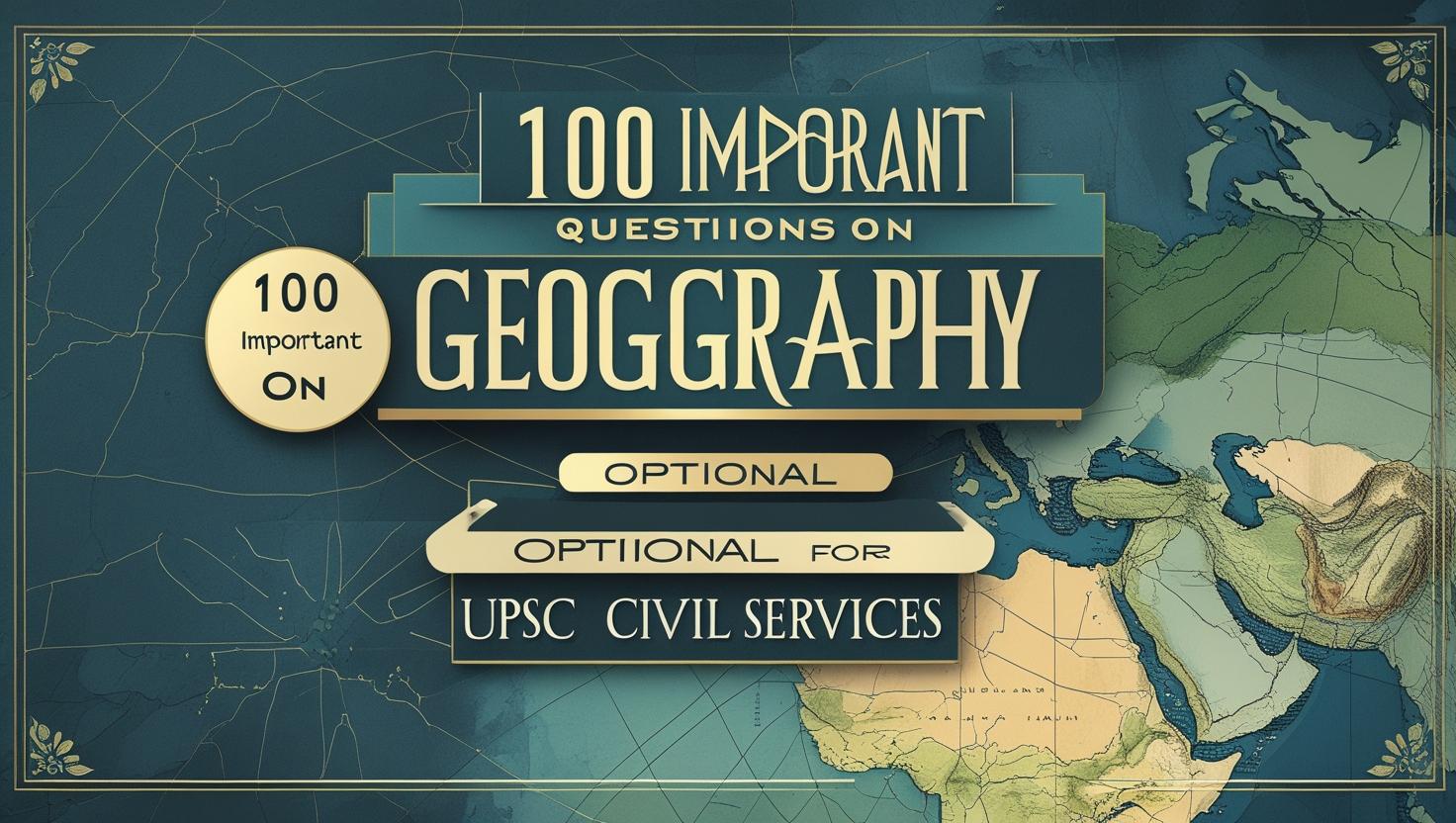Introduction
Geography is one of the most popular optional subjects for UPSC Civil Services aspirants because of its scientific nature, availability of resources, and overlap with General Studies papers. Preparing through important questions chapter-wise helps aspirants cover the syllabus in a structured way. Below are 100 important questions for Geography Optional, divided into chapters according to the UPSC syllabus.
For UPSC Coaching , Join FIRST IAS INSTITUTE (India’s Top IAS Coaching)
Chapter 1: Geomorphology
- Explain the concept of isostasy and its significance in geomorphology.
- Discuss the Davisian cycle of erosion and its limitations.
- Compare the models of landscape evolution proposed by Davis and Penck.
- What is plate tectonics? Explain its role in mountain building.
- Discuss the concept of continental drift with supporting evidences.
- Explain the processes of chemical weathering with examples.
- Discuss the geomorphic features associated with river action.
- Explain the theories of origin of the earth’s crust.
- What are coral reefs? Explain their types and distribution.
- Discuss the concept of slope development with reference to King’s theory.
Chapter 2: Climatology
- Explain the heat budget of the earth.
- Discuss the factors affecting the distribution of temperature on the earth’s surface.
- Explain the mechanism of monsoon in India.
- What are jet streams? Discuss their role in global climate.
- Explain the formation of cyclones and anticyclones.
- Discuss the vertical distribution of temperature in the atmosphere.
- What is inversion of temperature? Explain its types and effects.
- Discuss the concept of atmospheric stability and instability.
- Explain the process of precipitation and types of rainfall.
- Discuss the causes and consequences of El Niño and La Niña phenomena.
3: Oceanography
- Explain the origin of ocean basins.
- Discuss the types and characteristics of ocean deposits.
- Explain the causes and effects of tides.
- Discuss the factors controlling ocean currents.
- Explain the importance of thermohaline circulation.
- Discuss the role of oceans in regulating global climate.
- Explain the types and significance of coral formations.
- Discuss the upwelling phenomenon and its importance.
- Explain the marine resources and their economic significance.
- Discuss the role of oceans in the carbon cycle.

Chapter 4: Biogeography
- Explain the concept of ecosystem and its components.
- Discuss the classification of biomes with examples.
- Explain the energy flow in an ecosystem.
- Discuss the importance of biodiversity conservation.
- Explain the causes and effects of deforestation.
- Discuss the ecological succession with examples.
- Explain the distribution of major terrestrial biomes.
- Discuss the role of human activities in modifying ecosystems.
- Explain the concept of ecological balance.
- Discuss the importance of wetland ecosystems.
Chapter 5: Environmental Geography
- Discuss the causes and consequences of global warming.
- Explain the concept of sustainable development.
- Discuss the role of international conventions in environmental conservation.
- Explain the causes and effects of air pollution.
- Discuss the importance of renewable energy resources.
- Explain the problems of desertification and measures to control it.
- Discuss the role of environmental impact assessment.
- Explain the causes and impacts of water pollution.
- Discuss the concept of carbon credits and carbon trading.
- Explain the importance of environmental movements in India.
6: Perspectives in Human Geography
- Discuss the concept of determinism and possibilism in geography.
- Explain the concept of regional synthesis.
- Discuss the role of quantitative revolution in geography.
- Explain the behavioral approach in human geography.
- Discuss the concept of sustainable development in human geography.
- Explain the systems approach in geography.
- Discuss the concept of welfare geography.
- Explain the concept of cultural regions.
- Discuss the role of modern technology in geographical studies.
- Explain the concept of time geography.
Chapter 7: Population and Settlement Geography
- Discuss the theories of population growth.
- Explain the demographic transition model.
- Discuss the distribution of world population and factors affecting it.
- Explain the concept of optimum population.
- Discuss the rural-urban migration and its consequences.
- Explain the rank-size rule in urban geography.
- Discuss the primate city concept with examples.
- Explain the central place theory.
- Discuss the problems of urbanization in developing countries.
- Explain the concept of slums and their socio-economic issues.
Chapter 8: Economic Geography
- Discuss the factors affecting the location of industries.
- Explain Weber’s theory of industrial location.
- Discuss the role of transport in economic development.
- Explain the concept of agricultural regions with Whittlesey’s classification.
- Discuss the Green Revolution and its impact on Indian agriculture.
- Explain the concept of resource regions.
- Discuss the importance of energy resources in economic geography.
- Explain the concept of globalization and its impact on world economy.
- Discuss the problems of resource depletion.
- Explain the importance of information technology in modern economy.

9: Regional Planning
- Explain the concept of region and its types.
- Discuss the methods of delineation of regions.
- Explain the importance of regional planning in development.
- Discuss the growth pole theory.
- Explain the role of regional disparities in economic planning.
- Discuss the role of planning regions in India.
- Explain the importance of balanced regional development.
- Discuss the concept of special economic zones.
- Explain the role of regional planning in rural development.
- Discuss the importance of inter-regional trade.
Chapter 10: Geography of India
- Discuss the physiographic divisions of India.
- Explain the characteristics of Himalayan rivers.
- Discuss the climatic regions of India based on Koppen’s classification.
- Explain the distribution and significance of natural vegetation in India.
- Discuss the mineral resources of India and their distribution.
- Explain the problem of food security in India.
- Discuss the role of agriculture in Indian economy.
- Explain the importance of monsoon in Indian agriculture.
- Discuss the urbanization trends in India.
- Explain the role of transport and communication in Indian development.
Conclusion
Geography as an optional subject for UPSC Civil Services requires a deep understanding of both physical and human aspects of the subject. The above 100 questions, divided chapter-wise according to the UPSC syllabus, will help aspirants streamline their preparation, focus on important areas, and practice answer writing effectively.
Also Visit – Best IAS Coaching in India
For Answer Writing Techniques – Join FIRST IAS INSTITUTE

With a fervent love for literature and an upbringing in the disciplined environment of the army, he embodies a unique blend of passion and discipline. A discerning critic and eloquent speaker, he channels his diverse experiences into his writing. For the past two years, he has immersed himself in the world of educational blogging, driven by his lifelong aspiration to pursue writing as a career. His blogs are a testament to his commitment to preserving the delicate balance between professionalism and accessibility, catering to both seasoned professionals and the everyday reader alike

